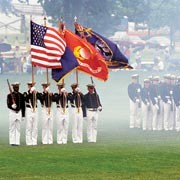Having 300 years of history behind you brings gravitas—and the right to party. So Maryland’s Colonial capital is doing just that in 2008 with a 300th Annapolis Alive! (www.anapolisalive.org) celebration of its designation as a city by a 1708 British Royal Charter.
Groups in residence find there’s nothing dull about Annapolis’ backstory. Sometimes called a “museum without walls,” the city’s historic district speaks volumes about another era from its walkable streets. And there’s even more heritage to discover from the waterways surrounding the city.
When the National Trust for Historic Preservation (NTHP) named Annapolis to its annual list of America’s Dozen Distinctive Destinations, Richard Moe, president of the NTHP, pointed to the city’s heritage attributes.
“Annapolis is no staid museum exhibit,” he said. “It’s a thriving, living community, with a waterside location that fosters boating and yachting, and summertime festivals that attract crowds to the City Dock for crisp salt air and views of sailing vessels. Charming and perennially welcoming, Maryland’s capital is also eminently accessible, situated less than 30 miles from either Baltimore or Washington, D.C.–great for a daytrip or a journey into the past.”
Precisely because it boasts such a great East Coast location that’s convenient to major urban centers and airports, yet so apart from 21st century sprawl and sameness, Annapolis is desirable for large and small groups, with a range of accommodations, activities and memorable off-site venues.
HistoryQuest, the welcome center near City Dock that depicts Maryland’s capital city history from creation to present day, is a good place to orient oneself. According to former Historic Annapolis Foundation President Greg Stiverson, the center has “delectable appetizers and hearty main courses” of history for visitors to consume. Takers enjoy videos, audio tours and a menu of other options about old Annapolis, culture, art, and geography.
Annapolis became the capital of the Maryland colony in 1694, and it enjoyed some A-list years before the American Revolution as a center of 18th century social life. It was a favorite haunt of George Washington, Thomas Jefferson and other gentry of those days who relished the city’s politics, pubs and vibrant city life.
That era lives on in some 1,500 restored historic buildings, including the nation’s oldest state capitol in continuous use. Grand estates remain along the Severn River to populate the views during cruises. Colonial-era homes and other vintage architecture radiate from the historic State House capitol to create a walkable district near City Dock that’s replete with restaurants, inns and shops.
Since its earliest days, Annapolis has been defined and sustained by water, first as a tobacco port at the mouth of the Chesapeake Bay and later as a working watermen’s town, and more recently as America’s sailing capital. Pleasure craft of all profiles pull into City Dock where piles of oyster shells some claim once reached 10 feet high.
The U.S. Naval Academy is one of Annapolis’ most popular attractions. Tours of the campus and academy history may coincide with the colorful pageantry of future naval officers assembling in formation before Bancroft Hall each day at noon. Lynne Forsman of Nautical Destinations says “groups often want tours of the campus, in tandem with a narrated river cruise and cocktails and dinner back on the waterfront.”
Whether by land or water, getting inside three centuries of Annapolis heritage can be an enjoyable program theme for groups who establish themselves in one of America’s truly unique cities.






